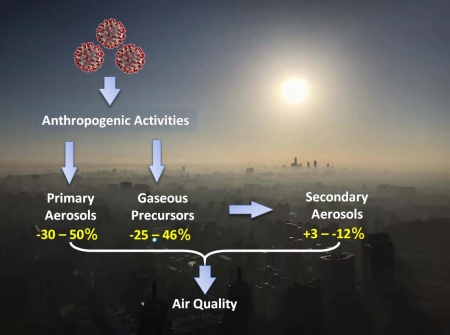The coronavirus disease (COVID-19) spreads rapidly around the world, and has limited people's outdoor activities substantially. Air quality is therefore expected to significantly improve due to the reduced anthropogenic emissions. However, the air quality in some megacities has not improved as expected and severe haze episodes still occurred during the COVID-19 lockdown.

Changes in primary aerosols, gaseous precursors, and secondary aerosols during the COVID-19 outbreak and Chinese New Year holiday (Image by LI Hao).
Professor SUN Yele and his team with the Institute of Atmospheric Physics at the Chinese Academy of Sciences analyzed six-year aerosol particle composition measurements to investigate the responses of air quality to the changes in anthropogenic emissions during the COVID-19 outbreak in Beijing, China along with the Chinese New Year (CNY) holiday effects on air pollution.
They found that air pollution during the COVID-19 lockdown is mainly due to the different chemical responses of primary and secondary aerosols to the changes in anthropogenic emissions.
"Primary gaseous and aerosol species responded directly to emission changes and decreased substantially by 30 – 50%", said SUN, "However, secondary aerosol species that are formed from oxidation of gaseous precursors (SO2, NOx, and VOCs) and accounted for > 70% of particulate matter remained small changes (< 12%). Therefore, fine particle pollution hasn't improved as expected."
The air quality in Beijing has significantly improved during the last decade, and the mass concentrations of both primary and secondary pollutants decreased considerably as a response of a national clean air action issued in 2013. However, according to this newly published study, the increased sulfur and nitrogen oxidation capacity have suppressed the effects of emission reductions due to enhanced secondary formation.
The findings, published in Sci. Total Environ, highlight a great challenge for mitigating secondary air pollution in regions with a cocktail of high concentrations of gaseous precursors.
"There’s an urgent need for a better understanding of the chemical interactions between precursors and secondary aerosol under complex meteorological environments." said SUN.
Reference:
Sun, Y., Lei, L., Zhou, W., Chen, C., He, Y., Sun, J., Li, Z., Xu, W., Wang, Q., Ji, D., Fu, P., Wang, Z., and Worsnop, D. R.: A chemical cocktail during the COVID-19 outbreak in Beijing, China: Insights from six-year aerosol particle composition measurements during the Chinese New Year holiday, Sci. Total Environ., 742, 140739, https://doi.org/10.1016/j.scitotenv.2020.140739, 2020.
Media contact: Ms. LIN Zheng, jennylin@mail.iap.ac.cn
